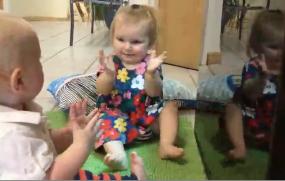Slapping mirror, then slapping hands

What you see in the video must look familiar, an infant slapping a mirror that reflects her image. Beatrix, age 9 months, slaps the polished panel repeatedly with both hands flat to the surface. How else is an infant to engage her own image? Just looking would not be enough. She wants some action that confirms the difference between her hands and those other hands in the mirror. When she slaps her hands to the mirror, her real hands come to an abrupt halt at the same time and place as her mirrored hands. Not only is she banging a surface, she is clapping with the hands in the mirror. Watch her eyes to see she if she attends to this meeting of four hands. Not always, but often enough. When she is not looking into the mirror we speculate that the abrupt stop at the same place each time interests her, not just the noise.
The slapping action against the glass somewhat ricochets into a clap of her two hands together (timecode 00:10). Beatrix continues to clap. Again, her hands come to an abrupt stop as they meet in the same place. She claps her two hands together at her midline several more times as if thinking, “yes, that feels similar to slapping the mirrored hands.” Perhaps she claps her hands as a way to assimilate what is happening when she slaps the mirror. Beatrix thinks, “I can either clap my real hands or clap the mirrored hands.” She might be intrigued with this strange way of clapping hands in the mirror. Her real hands are spaced apart and never come together; “how paradoxical it feels to clap my hands without clapping my hands.”
Clapping her own hands also gives Beatrix more choices about the orientation of her body. She claps while facing her friend Cosmos. The frontal orientation, child-to-child, serves as an invitation for Cosmos to imitate Beatrix, which he does. Around timecode 00:39 Beatrix makes three rather stylized “palms on” touches of Cosmos’ leg. In an exaggerated manner she touches his leg and draws her hand back, touches his leg and pulls back, touches his leg and pulls back. Why the exaggeration? Perhaps she has found another way to express this forward movement that comes to an abrupt stop when it arrives at a surface. She, in effect, claps his leg with one hand.
Beatrix returns to clapping her reflected hands in the mirror, transforms this to clapping her real hands at the midline, and that allows her to turn toward Cosmos and smile (timecode 01:01). Cosmos responds by leaning forward to touch Beatrix. The video skips a bit and returns to both children slapping the mirror. Beatrix expresses glee and now Cosmos is clearly in the mood to follow Beatrix’s lead. He claps when she claps. The game continues. Look carefully around 01:48. Beatrix slaps the mirror with one hand. This allows her to direct her gaze toward Cosmos at the same time she slaps the mirror. Her gaze implies an invitation to Cosmos to do what I am doing, or at least a means to see if he is preparing to follow. She then continues this one-hand clap to the mirror on its own merit, morphing that into a two handed clap at her midline. Has she by accident, or by design, now created a more analogous form of mirror clapping? One real hand clapping one mirrored hand creates an action more analogous to one real hand clapping another real hand.
Beatrix probably did not decide in advance to use real clapping to create analogies to the mirror clapping. Yet when these various actions happened we can venture she sensed some form of recognition in their similarities while preserving their differences. Play is often driven by the child’s discovery of these paradoxical contrasts. Indeed, the eventual encoding of these contrasts into consciousness forms the basis for logico-mathematical thinking.
Length of video: 2 minutes 2 seconds
Keywords: infants, mirrors, child-object, child-child, self-recognition, imitation
